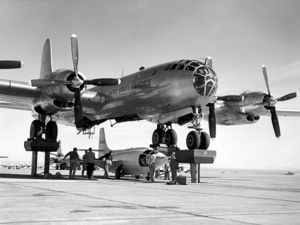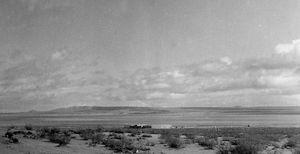First-Hand:Beyond Mach 1 - Chapter 5 of The Experimental Research Airplanes and the Sound Barrier: Difference between revisions
No edit summary |
|||
| Line 7: | Line 7: | ||
In addition to Bell Aircraft, the Air Force was also curious about the altitude potential of the X-1 as a ground based interceptor. This led to a ground takeoff experiment conducted by Yeager on 5 January 1949. This also might have been inspired by a rumor that the Navy was planning a rocket powered ground launch of the Douglas D-558-II research airplane. Yeager lifted off from Muroc Dry Lake in X-1-1 with all four XLR11 rocket chambers firing and in one and one half minutes reached a maximum altitude of 23,000 feet. This would be the only ground launch of any of the X-1 series. In April 1949 Air Force Major Frank Everest began a series of maximum altitude flights in X-1-1, and after a fourth attempt on 8 August 1949 went to 71,902 feet, this would be the highest altitude achieved by the original X-1 series. [39, p.19, pp.21-23] | In addition to Bell Aircraft, the Air Force was also curious about the altitude potential of the X-1 as a ground based interceptor. This led to a ground takeoff experiment conducted by Yeager on 5 January 1949. This also might have been inspired by a rumor that the Navy was planning a rocket powered ground launch of the Douglas D-558-II research airplane. Yeager lifted off from Muroc Dry Lake in X-1-1 with all four XLR11 rocket chambers firing and in one and one half minutes reached a maximum altitude of 23,000 feet. This would be the only ground launch of any of the X-1 series. In April 1949 Air Force Major Frank Everest began a series of maximum altitude flights in X-1-1, and after a fourth attempt on 8 August 1949 went to 71,902 feet, this would be the highest altitude achieved by the original X-1 series. [39, p.19, pp.21-23] | ||
In total, seventeen pilots made 156 flights in the first two X-1s, of which 82 were in the X-1-1 and 74 in the X-1-2. Pilots by agency were: Air Force - 8, NACA - 7, and Bell Aircraft - 3. The NACA flights, in particular, were oriented to instrumented research of stability and control, pressure distributions, structural loads, and pilot handling qualities at transonic and supersonic speeds. These flights spawned detailed research reports of much value to the American aircraft industry. On 12 May 1950, Chuck Yeager made the last flight of the X-1-1. This was not really a research flight but was rather made to provide film footage for the movie “Jet Pilot,” and after this, X-1-1 was sent off to the Smithsonian Institution. NACA pilot Joe Walker would make the last flight of the original X-1 series in X-1-2 on 23 October 1951. Engine start problems resulted in a glide flight only. After this flight the the nitrogen spheres used to pressurize the X-1-2 propellant tanks were found to be suffering from metal fatigue problems and the Air Force and NACA decided to | In total, seventeen pilots made 156 flights in the first two X-1s, of which 82 were in the X-1-1 and 74 in the X-1-2. Pilots by agency were: Air Force - 8, NACA - 7, and Bell Aircraft - 3. The NACA flights, in particular, were oriented to instrumented research of stability and control, pressure distributions, structural loads, and pilot handling qualities at transonic and supersonic speeds. These flights spawned detailed research reports of much value to the American aircraft industry. On 12 May 1950, Chuck Yeager made the last flight of the X-1-1. This was not really a research flight but was rather made to provide film footage for the movie “Jet Pilot,” and after this, X-1-1 was sent off to the Smithsonian Institution. NACA pilot Joe Walker would make the last flight of the original X-1 series in X-1-2 on 23 October 1951. Engine start problems resulted in a glide flight only. After this flight the the nitrogen spheres used to pressurize the X-1-2 propellant tanks were found to be suffering from metal fatigue problems and the Air Force and NACA decided to rebuild X-1-2 as a virtually new Mach 2.5 capable airplane - the X-1E. More about this later. [39, pp.21-23] | ||
==New Names== | ==New Names== | ||
Revision as of 20:52, 25 August 2016
By David L. Boslaugh, CAPT USN, Retired
To Mach 1.45 in X-1-1
Chuck Yeager broke the sound barrier in X-1-1 on 14 October 1947, and on 21 October, Muroc Test Unit pilot Herbert Hoover started the NACA research program with a familiarization glide flight in X-1-2. Nose wheel failure on landing kept the craft grounded for seven weeks. On 16 December Hoover became the first NACA pilot to use rocket power when he took X-1-2 out to Mach 0.71. Hoover and NACA pilot Howard Lilly then made six powered flights in No. 2 with Hoover achieving Mach 0.925 by the and of January 1948. Then on 10 March Hoover achieved Mach 1.065 and on 31 March Lilly made Mach 1.1 in No. 2, these being the first two NACA supersonic flights. In the mean time Chuck Yeager, on 26 March, had taken X-1-1 up to Mach 1.45 which would be the highest speed of the original X-1 series. [52, p.56] [39, pp .21-22]
In addition to Bell Aircraft, the Air Force was also curious about the altitude potential of the X-1 as a ground based interceptor. This led to a ground takeoff experiment conducted by Yeager on 5 January 1949. This also might have been inspired by a rumor that the Navy was planning a rocket powered ground launch of the Douglas D-558-II research airplane. Yeager lifted off from Muroc Dry Lake in X-1-1 with all four XLR11 rocket chambers firing and in one and one half minutes reached a maximum altitude of 23,000 feet. This would be the only ground launch of any of the X-1 series. In April 1949 Air Force Major Frank Everest began a series of maximum altitude flights in X-1-1, and after a fourth attempt on 8 August 1949 went to 71,902 feet, this would be the highest altitude achieved by the original X-1 series. [39, p.19, pp.21-23]
In total, seventeen pilots made 156 flights in the first two X-1s, of which 82 were in the X-1-1 and 74 in the X-1-2. Pilots by agency were: Air Force - 8, NACA - 7, and Bell Aircraft - 3. The NACA flights, in particular, were oriented to instrumented research of stability and control, pressure distributions, structural loads, and pilot handling qualities at transonic and supersonic speeds. These flights spawned detailed research reports of much value to the American aircraft industry. On 12 May 1950, Chuck Yeager made the last flight of the X-1-1. This was not really a research flight but was rather made to provide film footage for the movie “Jet Pilot,” and after this, X-1-1 was sent off to the Smithsonian Institution. NACA pilot Joe Walker would make the last flight of the original X-1 series in X-1-2 on 23 October 1951. Engine start problems resulted in a glide flight only. After this flight the the nitrogen spheres used to pressurize the X-1-2 propellant tanks were found to be suffering from metal fatigue problems and the Air Force and NACA decided to rebuild X-1-2 as a virtually new Mach 2.5 capable airplane - the X-1E. More about this later. [39, pp.21-23]
New Names
As supersonic flight research was progressing, the organizations conducting the research were not standing still either. On 10 February 1948 the United Stated Air Force was established as a separate military service, and Muroc Army Air Field was renamed Muroc Air Force Base. Then on 14 November, in recognition of the growing workload and manning of the NACA Muroc Flight Test Unit, the organization, by then having about 100 employees, was designated the NACA High-Speed Flight Research Station (HSFRS). Walt Williams was named Chief of the Station. In December 1949, Muroc Air Force Base was renamed Edwards Air Force Base in honor of Captain Glen Edwards, who had been killed a year earlier in the crash of the Northrop YB-49 Flying Wing. [13]
The reader will recall that the Air Force originally authorized three of the original X-1 series. But, in April 1948 the Air Force contracted with Bell Aircraft to build a new series of higher performance research airplanes to be designated X-1A, X-1B, and X-1D, and reprogrammed the funds for the X-1-3 to the new series. The history of these airplanes will be covered in a later section. The X-1-3 was to use a newly developed turbopump to deliver propellant to the rocket engine, and dispensed with the large nitrogen pressurization spheres. This resulted in a considerable space and weight savings, and enabled larger fuel tanks that could bring maximum speed up to Mach 2.4, whereas the first two X-1s could only reach Mach 1.4. NACA elected to fund construction of the X-1-3 so that they could have their own Mach 2.4 research airplane, and it was delivered to the High Speed Flight Research Station in April 1951.
The Bell X-1-3 being loaded into the bomb bay of its mother plane B-50 - 9 November 1951. The craft made only one glide flight before its destruction in a mysterious explosion. NACA photo
Before NACA formally accepted the new airplane, Bell Aircraft was to make a series of qualification flights, and on 20 July Bell pilot Joseph Cannon was carried aloft in X-1-3 to make a glide flight. The next flight did not come until 9 November, and this was to be a captive flight with the plane loaded with liquid oxygen and alcohol propellant to test the jettison system. No drop was planned. For reasons not fully understood, the nitrogen bottles that provided jettison pressure to the propellant tanks did not work, and the decision was made to land with the X-1-3 still in the bomb bay, and still full of propellants. Once on the ground, the B-29 was moved to a remote area where the nitrogen b ottles could be repressurized and the propellants jettisoned. Cannon re took his place in the X-1-3 cockpit to run the jettison sequence, and began pressurizing the liquid oxygen tank. His movement of the nitrogen valve was followed almost immediately by a muffled explosion somewhere inside the X-1-3. A few seconds later the research airplane erupted in a violent explosion, and a badly burned Cannon was pulled away from the conflagration. Both the X-1-3 and the mother plane were destroyed in the resultant fire. Cannon recovered from his burns, and the accident review board decided that the explosion had been caused by the shattering of a pressurized nitrogen container that had become brittle due to being super cooled by the nearby liquid oxygen tank. The board reasoned that nitrogen container fragments then tore up the fuel and liquid oxygen tanks, leading to the second explosion. The X-1-3 research career was over before it started, with only one glide flight. [46] [39, p.21]
In August 1951, Congress appropriated $4 million to build new facilities for the High Speed Flight Station on the “shore line” of Muroc Dry Lake. The builder broke ground on 27 January 1953, and the new station opened on 26 June 1954. The new site would have a central office and laboratory building with hangars on either side having shops, aprons, and taxiways. The HSFS staff moved from the leased Air Force hangar at the South Base on 26 June 1954. The High Speed Flight Station is at the center of the photo, and the lake bed behind; running from side-to-side of the photo. By this time the Air Force had established the Air Force Flight Test Center and Test Pilot’s School about a mile south on the lake shore.

